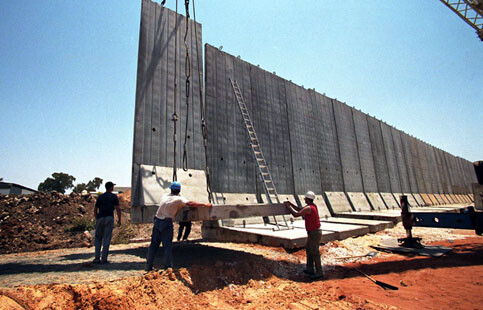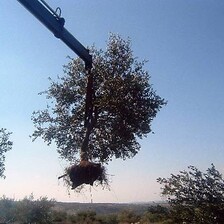The Electronic Intifada 25 April 2003

Above: Israeli construction workers lower another section of the wall into place near Qalqiliya. (Ronald de Hommel)
Jerusalem (20 April 2003)—I first went to visit the West Bank wall last August. I visited the city of Qalqilya and several villages in the area, including Jayyous. I was not the only one who went that day.
Hundreds of Western journalists, and more importantly many representatives of foreign embassies, have made the trip to see the wall since then. I daresay numerous reports have been made by people such as me who went to see the wall. Certainly, plenty of information has been published in the Western media, as well as alarming photographs of the oppressive and ugly wall, so I am sure that even more has been written behind closed doors.
The wall is no secret. Even if people have not visited Qalqilya and Jayyous, the story is there in the newspapers. Or here, on this website. The people of Qalqilya are locked in a prison. There is only one way out, and few have permits to leave so as to find work elsewhere. Half the farmland is now gone and vital water supplies have been cut off. Palestinians do not have the permission to dig for more water. Israel is unilaterally setting boundaries, with no negotiation, no court of appeal.
In the heat of last summer, I, like many other foreigners, went to visit the farmers in Jayyous. Five and a half kilometers from the 1967 border, the people of Jayyous have lost 75% of their farmland and seven artesian wells, all of which were confiscated to build this so-called “security wall.” As a farmer handed me an orange from what could well have been his last harvest, he told us what was happening. Some of the land that he was using was irrigated thanks to a development project funded by the French government. The French sent a representative who, according to the farmer, was horrified by the latest Israeli theft of Palestinian land, yet another Israeli violation of the Fourth Geneva Convention.
So, with all these international visitors and the promise of the “roadmap,” has anything changed in the seven months since I first visited the wall?
On my visit last week I found some definite changes. The Israelis have taken more land since I was there. And the land that remained? “They attacked our farmers with dogs when we tried to go to the land,” Fayez Salim, the mayor of Jayyous, told me. “And in any case, much of the remaining land has dried up as we have no water to irrigate it.”
In Qalqilya, Mayor Marouf Zahran told me that the owners of more than 600 shops have informed the municipality that they are closing. He estimates that around 3,000 of the 41,600 inhabitants have been forced to leave Qalqilya because of economic necessity. As the nearest town to the 1967 border, the Qalqilya used to rely on Israeli customers. Only 12km from Tel Aviv and the coast, both Israeli Jews and Palestinians used to flock to the city from the other side of the Green Line. Qalqilya is situated in the most water-rich area of the whole West Bank. Fruit and vegetables were exported out of Qalqilya abroad. Now families are lucky if they have enough land to support themselves.
The Israeli occupation rendered the West Bank and Gazan economies completely dependent upon the richer occupiers. Now that the borders have been closed, the Palestinians can neither maintain their own economy nor earn wages as cheap labour for the Israelis. Qalqilya is a ghost town. The wall is complete on the west side, and the building continues at the east side.
“Excuse me,” I want to ask Israel, “didn’t you say this wall was simply a security border between Israel and the West Bank?” “The Israelis promised us access to the land,” said Mayor Zahran, “but in nine months we haven’t got that.” Not only has Qalqilya been ghettoized, but the 32 villages in the area have also been divided by fences into three zones, preventing villagers from visiting each other, or traveling to Qalqilya for medical care.
Not only have farmers been separated from their land, but families are now divided. “Those with permits have had to make a decision on which side to live. And those are the lucky ones. Many are divided without even the choice to remain on one side or another.” Nidal Jalood from Qalqilya Municipality points out the settlements: “That’s Alfei Menashe with the red roofs. The largest settlement in the area,” he said. “And that one over in the distance is where [former Prime Minister] Barak has his house. He used to fly his helicopter over us every morning to get to Jerusalem.”
Mr. Jalood took me to an area where Israelis bulldozers were digging the trenches for the latest stretch of the wall/fence/barrier. Families from the villages were taking the limited opportunity to cross into Qalqilya through this muddy field. “They are doing us a favour today,” said one man without smiling, “they have opened the gate for the bulldozer, so they are letting us walk through. I usually have to walk several extra kilometers to get in.” At his side, his wife was struggling with a shrieking and sick baby. They were on their way to hospital, but of course, from the villages they cannot bring their car.
“This is our fate,” said another woman, as she had to hitch up her skirts to walk though the 7-foot ditch that would soon be filled with “wall.” Her small child fell right over on the uncertain surface. “Shameful!” said Mr. Jalood, looking away from the women forced to stagger ungracefully in the dirt and mud.
“It’s not legal to build the wall near our school” and “Give us our freedom!” read the graffiti on the wall of a village school I drove past. Legal according to whom? Looking at events in Palestine and Iraq, the whole concept of international law and the existence or authority of an independent arbiter seems sadly remote and unlikely.
“We don’t have social security, the land was our social security,” Mr Jalood told me. The land is not just some kind of communal and nostalgic longing for the past; for Palestinians in the West Bank, their very lives and futures depend on it. “When you lose your land, you lose your sanity, it makes you crazy.” says Jayyous Mayor Salim. Another Jayyous man, a construction supervisor, told me how he had lost 600 dunams of olives, oranges and other crops. All his land. Not lost, but stolen.
The Mayor himself is not exempt from the suffering. Of 400 olive trees, he now has about 40 left. He has five sons and two daughters, 18 individuals in his extended family. “How can I support them now?” As mayor he has the job of cutting off the electricity of those who cannot afford the bills. Recently he had the horrific task of cutting his own daughter off because she and her husband could not pay.
His office window gives him a clear view of Israeli territory, and the land that has just been confiscated from Jayyous. “We need peace, why can’t we have equality? Nobody wants to die, I wouldn’t like to die, but we know that we won’t leave like in 1948. Where could we go? Jordan? Iraq?” he says with an ironic laugh. “The younger generation knows what happened in the past and they say we will stay. We are afraid of transfer but we refuse to leave.”
So with all these international visitors, from American, Italian, French and UN delegations and nothing happening on the ground, does anyone want to contradict Omar, a farmer who has lost more than half of his land, when he says: “It’s the Zionists working with the British again. Look at Iraq. And look at my farmland.”
Does anyone have any positive news about the “Road Map” with which to convince Omar that the international community is not colluding with, or at least allowing, the Zionists to get away with illegal acts such as land theft and population transfer? Can you look Omar or the mayor of Jayyous in their eyes and tell them that the international community is committed to a just solution on the ground? I can’t.
So don’t hold your breath and simply hope that a second nakba (catastrophe) won’t happen. It is already unfolding, right beneath our noses.
More details about the wall: Building a Wall, Sealing the Occupation, by Isabelle Humphries, Middle East Report Online, 29 September 2002.
Isabelle Humphries has been living between Nazareth and Jerusalem during the Al-Aqsa Intifada. She is conducting academic research on the situation of Palestinian refugees inside the Green Line. Isabelle can be contacted at innazareth@yahoo.co.uk





